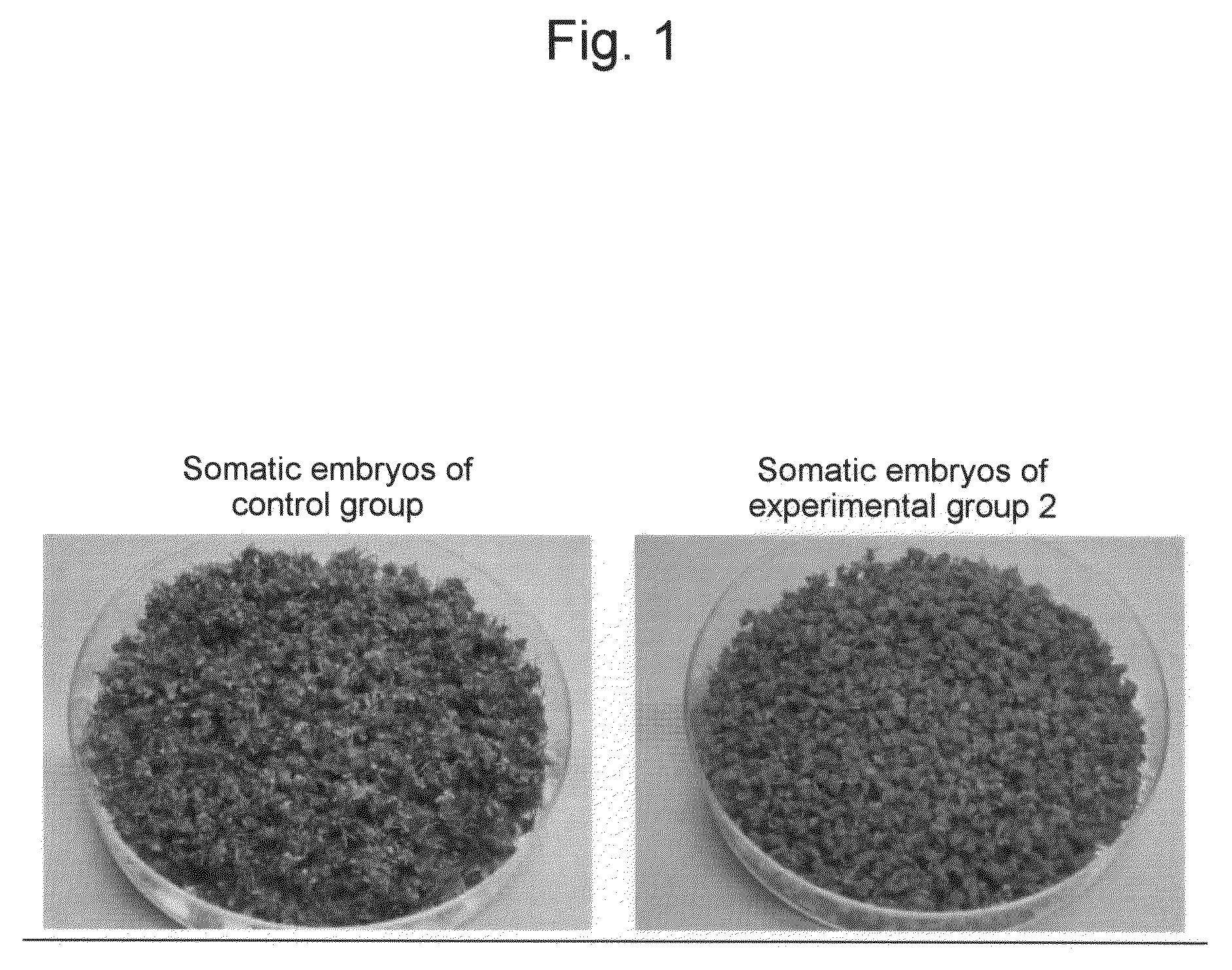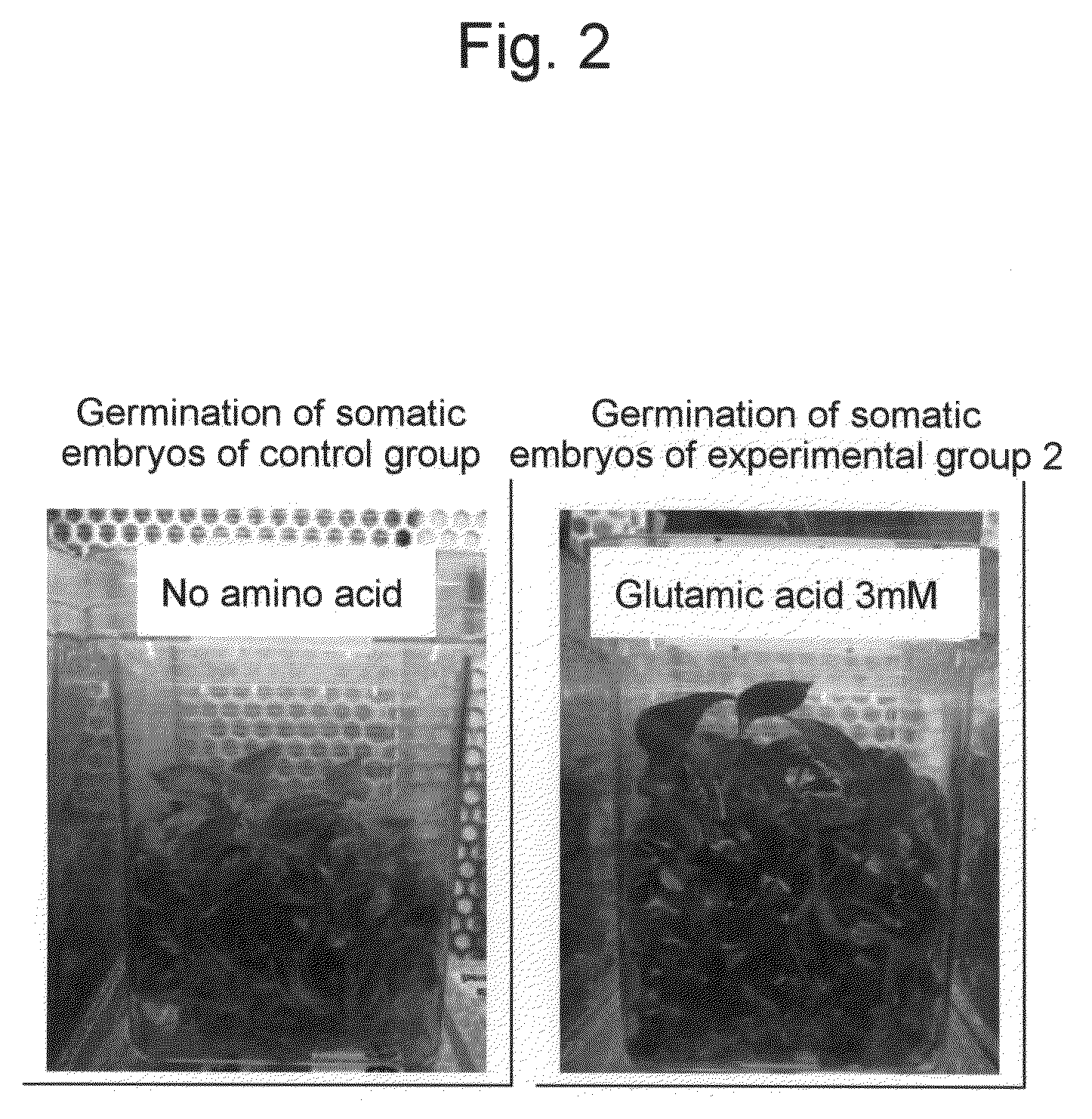Method for Propagation of Plant
a plant and plant technology, applied in the field of plant propagation, can solve the problems of low propagation rate, low working efficiency, and difficulty in mass propagation without manual techniques
- Summary
- Abstract
- Description
- Claims
- Application Information
AI Technical Summary
Benefits of technology
Problems solved by technology
Method used
Image
Examples
example 1
[0044]The present invention is further illustrated in detail with reference to the following examples. However, these examples do not limit the scope of the present invention.
[0045]Callus induction from various tissues of the cultured seedlings of Spathiphyllum (cultivar Petite) and embryogenic callus induction from the aforementioned callus were performed. The cultured seedlings had been maintained with the subculturing thereof on solid medium prepared by adding 3% sucrose and 0.8% agar (Wako Pure Chemical Industries, Ltd., Tokyo, Japan) to MS medium under conditions of a pH adjusted to 5.8, a light place (photosynthetic photon flux density of 5.7 μmole / m2 / sec and a day length of 16 hours), and 25° C. Plant boxes (produced by Asahi Techno Glass Corporation) were used as culture containers (internal volume 300 ml). On week 4 of culturing, leaf sheaths were collected from the cultured seedlings such that the leaf sheaths were peeled off from the strains. Roughly-2-cm sections (leaf s...
example 2
[0048]The effects of proline and glutamic acid on somatic embryo induction were examined using embryogenic callus of the cultivar Petite, which had been induced under the same conditions as those of Example 1. MS liquid medium (pH 5.8) containing 1% sucrose, 3% sorbitol, and MES 5 mM was used as basal medium. Proline and glutamic acid were added to the media at the following concentrations. Subsequently, 0.05 g each of the embryogenic callus was placed in a 300-ml Erlenmeyer flask (5 flasks per group) containing 40 ml of each medium and then cultured with shaking (70 rpm) for 6 weeks at 25° C. in a light place (a day length of 16 hours and photosynthetic photon flux density of 22.8 μmole / m2 / sec). The fresh weights the thus induced somatic embryos were measured (Table 1).
TABLE 1Effects of proline and glutamic acid on somatic embryo inductionProlineGlutamicAmount of embryoGroup(mM)acid (mM)collected (g / flask)Control group002.1Experimental group 1303.4Experimental group 2033.5Experimen...
example 3
[0050]Somatic embryo induction was performed in a fermenter using embryogenic callus of the cultivar Petite, which had been induced under the same conditions as those of Example 1. As medium for somatic embryo induction, MS medium supplemented with 1% sucrose, 3% sorbitol, 0.02 ppm 2,4-D, 3 mM proline, 3 mM glutamic acid, and 5 mM MES (pH 5.8; hereinafter, “somatic embryo induction medium”) was used. As a fermenter, a cylindrical fermenter (internal volume of 8 l; hereinafter, “somatic embryo induction fermenter”) having agitation wings with a width of 15 cm (produced by SIBATA SCIENTIFIC TECHNOLOGY LTD), a bottom area of 314 cm2, and a height of 24 cm was used. Two (2) g each of embryogenic callus was placed in a fermenter (a total of 9 fermenters) containing 5 l of somatic embryo induction medium. Somatic embryo induction was performed by rotating the agitation wings at a rate of 50 rpm (per minute) while performing aeration (0.06 vvm) from the bottom. Culturing was performed unde...
PUM
 Login to View More
Login to View More Abstract
Description
Claims
Application Information
 Login to View More
Login to View More - R&D
- Intellectual Property
- Life Sciences
- Materials
- Tech Scout
- Unparalleled Data Quality
- Higher Quality Content
- 60% Fewer Hallucinations
Browse by: Latest US Patents, China's latest patents, Technical Efficacy Thesaurus, Application Domain, Technology Topic, Popular Technical Reports.
© 2025 PatSnap. All rights reserved.Legal|Privacy policy|Modern Slavery Act Transparency Statement|Sitemap|About US| Contact US: help@patsnap.com



